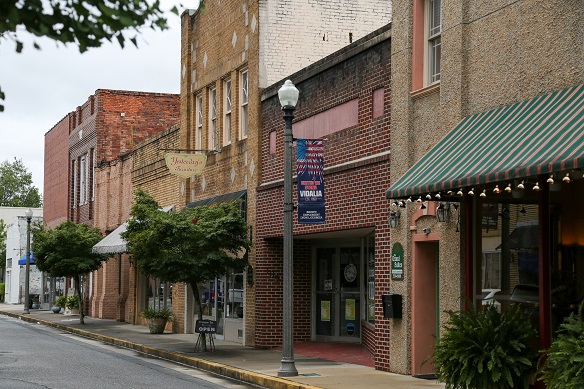
Toombs County was created in 1905 from Emanuel, Montgomery, and Tattnall counties. It was named for Robert Toombs, a former U.S. congressman and senator who went on to serve the Confederacy as Secretary of State and brigadier general. The land was originally held by Creek Indians. A large percentage of the earliest white settlers were Scots Highlanders, many of whom lived in North Carolina before they came to Georgia.
A land of forests and wiregrass, Toombs County was dominated by small farms concentrating on livestock, corn, and cotton during the nineteenth century. The arrival of railroads in the 1890s brought settlers from nearby counties and North Carolina. Interested in tapping the forests for timber and naval stores, the settlers built houses along the railroad lines, and towns sprang up around the clusters of homes.
Lyons, the county seat, was incorporated in 1897. It was named in honor of the man who convinced the Seaboard Air Line Railway to build tracks through the town. The first courthouse, completed in 1906, burned down in 1917 and was rebuilt in 1919. The current courthouse was built in 1964.
Other incorporated towns in Toombs County are Santa Claus and Vidalia. Santa Claus, incorporated in 1941, was named by a local farmer who hoped the name would attract tourists to stop for his pecans. Vidalia, incorporated in 1890, was originally called Jenkins Station for its railroad depot, which was named after local landowner Warren T. Jenkins. There are conflicting stories regarding the origin of the name "Vidalia," the most likely being that it was assigned by a daughter of Samuel Hawkins, the president of the Savannah, Americus and Montgomery Railroad. She may have found the name on a document or map referring to Vidalia, Louisiana, or she may have contracted the words "via" and "dahlia" (by the route of the dahlias) to form the name. Current maps of Toombs County include the unincorporated communities of Cedar Crossing, Johnson Corner, Normantown, and Ohoopee.
Although the Great Depression brought the same kinds of social and economic problems to the county as were experienced across the nation, Toombs was able to rebound soon afterward, as the country prepared for and engaged in World War II (1941-45). During the war, a U.S. Army Air Force field was located in Vidalia, and large numbers of residents joined the military. Businesses supporting military personnel and industries supplying the war effort thrived. Prosperity continued after the war ended; Vidalia grew into a regional trade center and continues to flourish.
Tobacco was a large part of the county's early economy, but for decades the county's most famous crop has been the Sweet Vidalia® Onion, which gave Vidalia the nickname "Sweet Onion Capital of the World." The onion is sold all over the United States and attracts tourists to Toombs County for the annual Vidalia Onion Festival.
A number of noteworthy Georgians have called Toombs County home. Iris Faircloth Blitch, the first woman to serve two terms in the Georgia senate (1946-48 and 1952-54), later became one of the first women from Georgia to win a seat in the U.S. Congress (1955-63). Mel Blount, a professional football player for the Pittsburgh Steelers; James T. McIntyre, the director of the Office of Management and Budget during Jimmy Carter's presidency; and restaurateur Sema Americus Wilkes, proprietor of the nationally known Savannah restaurant Mrs. Wilkes' Dining Room, also resided in the county.
The John E. Ladson Genealogical and Historical Library, established in the 1940s by its namesake, is now housed and maintained by the Ohoopee Regional Library System in Vidalia.
Toombs County boasts several buildings and areas listed on the National Register of Historic Places. The Altama Museum of Art and History in Vidalia, housed in the Brazell House, holds several noteworthy permanent collections, including a large collection of Staffordshire porcelain and prints by John James Audubon, as well as a room dedicated to the history of the Girl Scouts. The Seaboard Air Line Railway Depot was built in 1930 and renovated in 1990 to serve as a community center for Lyons.
The Southeastern Technical College operates several facilities within the county.
Courtesy of Georgia Archives, Vanishing Georgia Collection Ice Plant, Edwin Jackson, Carl Vinson Institute of Government, University of Georgia and the Georgia Department of Economic Development.




